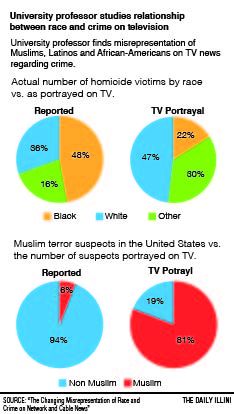Television news misrepresents Latinos and Muslims, University professor finds

April 21, 2015
Television news misrepresents different ethnic groups, specifically in crime reports, according to statistics gathered in a new study.
The portrayal of homicides against white victims is 11 percent higher on television news than the actual percentage in real life. The number is 26 percent lower for African-Americans, and 14 percent higher for other races, according to the study, conducted by Travis Dixon, a University communications professor, and Charlotte Williams, associate professor and director of the Center on Community Philanthropy at the University of Arkansas.
Dixon said the research, titled “The Changing Misrepresentation of Race and Crime on Network and Cable News,” found how various topics change in the news and how the news depicts certain groups as victims, perpetrators or heroes.
Ethnic groups are misrepresented in cable and network news because of ethnic blame discourse, appealing to larger audiences and a concept called guard dog perspective, Dixon said.
Ethnic blame discourse is a way journalists, news editors, publishers and others frame narratives and put blame on a particular group; guard dog is when the media tries to determine whether the audience needs to be protected from outside forces, such as the “elite.”
Get The Daily Illini in your inbox!
“If you look at the national news, they do not normally have just regular crime stories occurring on the news,” Dixon said. “What they do have are policy debates about immigration, terrorism, torture — all those things and they involve these actors.”
These actors in immigration policies tend to be Latino and Muslims, who tend to be depicted in acts of terrorism.
He also found that African Americans were underrepresented on cable news, both as victims and criminals.
Ismaeel Sheriff, freshman in Engineering, said he never saw references to Muslims in the media until recently.
“At first, they were mostly negative, and I did not feel content with it because there was not an opposing viewpoint,” Sheriff said. “It was mostly showing (Muslims) as terrorists and as bad guys in movies and shows.”
Sheriff said media caters to the majority of opinion because of the media’s influence.
“It is because of the media that I started looking into my own religion and learning about it,” Sheriff said. “Even though I am Muslim and I disagreed with some of the portrayals, it still made me wonder and helped me become more Muslim.”
Dixon said news providers want to make more money by sharing news that has emotional appeal to the audience. He said delivering accessible news allows the audience to understand and follow the content more closely, leading to more viewers, even if that means stereotyping certain groups.
“These other stories are often re-told in ways that every time you see a story about immigration it is always (about a) Latino,” Dixon said. “Every time you see a story about terrorism it is always about Muslims and talking about Muslims in as negative a way as much as possible.”
Gioconda Guerra Perez, director of La Casa Cultural Latina, said she has heard some of students’ concerns and experiences about being stereotyped or being targeted against just for being Latino.
She said Dixon’s research helps the community speak more about what is occurring in cable news and media.
“If the story found those things in which Latinos are often linked with problem issues that negatively impact community, both directly and indirectly, it is going to affect society as a whole,” Guerra Perez said. “Not being portrayed correctly, we are damaging a whole community, making them not only a target, but at the same time, promoting stereotypes that are very negative for a group.”
Dixon said the main way to prevent stereotypes is to hear someone’s story and know there is diversity across all groups of people. He said students on campus can feel they may have experienced this media coverage directly.
“Knowing that (students) are being seen through that lens, it might be directly affecting them in that sense. That there are questions about their loyalty to America, their ‘Americanness,’ the extent to which they feel welcomed on campus and that they fit in,” Dixon said. “I think might be a challenge for them.”






